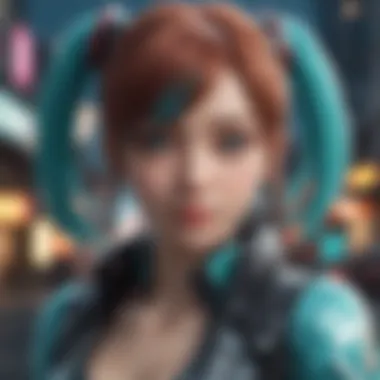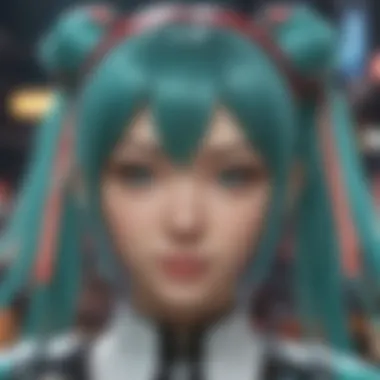Unpacking the Miku Game Phenomenon in Mobile Gaming


Intro
The Miku game phenomenon stands at a unique intersection of gaming culture and fan engagement. Originating from the Hatsune Miku franchise, these games revolve around a virtual singer developed by Crypton Future Media. What started as Vocaloid software for music has transformed into a rich vault of mobile games that attract gamers from diverse backgrounds. This exploration highlights the various facets of Miku-themed games, notably their gameplay dynamics, visual appeal, and the community that forms around them.
Understanding the success of these games involves an examination of key gameplay mechanics, striking graphics, engaging storylines, and significant in-game features. Additionally, community interactions provide layers of insight, revealing experiences from a wide span of players. With this article, we comparisonize different aspects and outline practical tips for both novice and seasoned gamers alike, ultimately leading to a comprehensive overview of the Miku-inspired gaming landscape.
Game Review
Gameplay Mechanics
Gameplay is central to the gaming experience, and Miku games often embrace rhythm-based mechanics. Players primarily interact by tapping, swiping, or holding notes on screen, synchronized to musical tracks. Elements vary across titles; however, one consistent feature is introducing diverse difficulty levels. Various modes allow for progressive skill mastery, ensuring enjoyment for both casual players and rhythm game veterans.
A prominent title, Hatsune Miku: Colorful Stage!, exemplifies these mechanics. Players can collect cards of their favorite virtual idols to enhance performance and experience. Easy integration of past tracks alongside original compositions provides a layered experience, appealing to enthusiasts of both gaming and music.
Graphics and Visuals
Visually, Miku games invest heavily in icons and aesthetics that draw players in. Often, the distinctive art style merges anime influences with vibrant animations. Character models jump off the screen with detail in costumes and motion fluidity during performances. Each Miku game is a canvas for artistic creativity that respects the source material while enhancing player immersion.
Furthermore, the background designs vary from concert stages to fantastical worlds, each tailored to fit specific musical themes. The light shows and animations are essential in capturing the essence of live performances, triggering an almost euphoric experience.
Storyline and Narratives
Many Miku games do not solely focus on rhythm-sense duties; storylines emerge that flesh out characters and their world. Often interspersed with musical elements, the narratives evolve while developing connections between the player and idols. Games like Hatsune Miku: Project DIVA carry rich, contrasting stories that can shift from whimsical to serious, enriching the player's overall immersion.
Fans find unique joy in dive into innermost aspects of their favorite characters' lives, spanning narratives that included conflict and friendship with Miku as both a guide and a protagonist.
In-game Features and Customization Options
Customization is a focal point encouraging creativity. Players have options to personalize their avatars and construct ideal settings, tailor-suited for typical preferences like music or character aesthetics. Features like skin-changes, accessories, costumes, and skill upgrades entice crucial player engagement.
In addition, players enjoy modest game modes aimed at friendly play: competitive leaderboards, online multiplayer, and immersive social features enhance interaction between players while expanding horizons for various game-play styles.
Prologue to Miku and Its Impact on Mobile Gaming
The Miku game phenomenon represents a unique intersection of virtual idol creation and mobile gaming culture. Exploring this topic allows us to see how these facets combined influence a wide audience. Understanding Miku's rise, from merely a character in digital songs to an engaging mobile gaming presence offers insights into audience engagement, game development trends, and marketing strategies in the gaming industry.
Miku's impact stretches beyond entertainment; it encapsulates technological advancement in interactive media and the power of fandom dynamics. So, the analysis of Miku helps unveil broader implications for mobile development, highlighting community interaction, user-generated content, and evolving gaming paradigms.
Origin of Miku as a Virtual Idol
Hatsune Miku first appeared as a synthesizer software developed by Crypton Future Media. Released in 2007, Miku taps into vocoder technology to allow users to create music that captures personal expression. Her design features a blue-haired girl, which sets her apart visually and generates intrigue among audiences.
Her popularity surged as users began composing and sharing songs. Online platforms such as Nico Nico Douga and YouTube enabled creators to showcase their work. Miku adapted uniquely to the digital landscape. This emergent online culture acted as a cornerstone in establishing her identity as a virtual idol. With each new song and performance, her brand expands amidst genuine fan engagement.
Key Developments of Miku's Initial Premise
- Technological Foundations: Miku represents advancements in audio software, bringing new avenues for music production.
- Cultural Acceptability: The integration of cute avatar forms encouraged a diverse demographic.
- User-Driven Content: Fans produced countless remixes, expanding Miku’s universe.
These elements provided necessary impetus for her crossover into the gaming world, essentially ushering the shift toward Miku-themed games catering to various audiences.
Evolution of Miku Games


Miku games began modestly but witnessed tremendous growth and sophistication over the years. The transition can be traced mainly through rhythm and rhythm-action games. Miku: Project DIVA series marks a key development, which blends traditional rhythm gameplay with immersive graphics, taking advantage of Miku as a flagship.
As technology progressed, developers began introducing more complex mechanics and customizable character options. For instance, players can choose different outifts and instruments during gameplay. Noteworthy is the inclusion of storyline elements, drawing players into the narrative offered by gameplay, enhancing the experience even more.
Through expanding genre presence, Miku games effectively reach lost gamers as well, fusing variety and innovation related to mash-up gameplay assigned to mobile formats. As a result, players participate not only in mere mechanics but also involve themselves within wider game narratives, enjoying layered structures.
The careful weaving of music, graphics, and gameplay assures Miku continues be relevant. With her adaptability, moving within different genres and styles, Miku has firmly established herself in gaming as both an icon and a catalyst for gamer interaction.
Game Mechanics of Miku-themed Titles
The game mechanics of Miku-themed titles form a significant core of what attracts players to these experiences in mobile gaming. The combination of engaging gameplay elements and an immersive environment enhances the appeal of these titles. They reflect the intricate relationship between players and characters, and they contribute to extending the lifecycle of engagement within the Miku game phenomenon. Understanding these mechanics can illuminate why Miku games continue to thrive in the crowded domain of mobile gaming.
Rhythm Game Elements
At the heart of Miku-themed games lies the rhythm-based gameplay, a feature that has distinguished them from other genres. Games like Miku: Project DIVA showcase rhythm mechanics that require players to interact with the game by pressing buttons in sync with the music. This not only intensifies player engagement but also deepens the emotional connection between individuals and the catchy soundtracks performed by Miku.
The rhythm game elements comprise several key aspects:
- Timing: Players must perform actions based on precise timing, enhancing satisfaction upon successful execution.
- Visual Feedback: Players receive instant visual feedback that rewards accuracy, which fosters a sense of accomplishment.
- Varied Difficulty Levels: The inclusion of multiple levels of difficulty caters to gamers of diverse experience levels, maintaining interest over time.
These features allow Miku games to appeal to both casual players and those seeking hardcore challenges, maintaining high player retention rates.
Character Customization Options
Character customization options in Miku games invite players to tailor their experience and express personal creativity. These customization elements range from altering outfits to changing hairstyles, providing vast choices. This aspect is integral to the game experience as it fosters a sense of ownership of their character, making players feel more connected to the virtual idol.
Customization often includes:
- Outfit Selection: Players can modify Miku's attire, with many options reflecting different styles and themes.
- Accessories: Availability of various accessories allows further personalization, strengthening player immersion.
- Visual Settings: Gamers can modify visual elements in the game settings, enhancing the overall aesthetic of gameplay.
The option for individualized customization serves dual purposes; it leads to greater satisfaction for players and extends the replay value of the games, creating a dynamic ecosystem where creativity and enjoyment intertwine.
Difficulty and Accessibility
The balance of difficulty and accessibility addresses broader gamer consideration in Miku titles. Developers have been attuned to create engaging, yet welcoming game experiences. The adjustable difficulty levels enhance player satisfaction, ensuring that both newbies and veterans do not feel alienated.
Key considerations include:
- Adaptive Difficulty: Many Miku games incorporate systems that adjust challenges based on player performance, ensuring a suitable level of difficulty.
- Tutorials and Practice Modes: These features enable new players to grasp game mechanics, allowing a smoother introduction into the rhythm representations.
- Inclusive Options: Accessibility mode options are aimed towards gamers with different levels of ability, promoting a diverse player base.
A focused design approach in terms of difficulty can influence a game's success, as seamless adaptation enhances player enjoyment, bringing a commendable approach to the mobile gaming market overall.
Cultural Significance of Miku in Gaming
The cultural significance of Miku in gaming is multifaceted, reflecting broader trends both in digital entertainment and social interaction. Through ongoing community engagement, fan creations, and her role in Japanese pop culture, Miku demonstrates an influential presence, not just as a character but as an emblem of a larger cultural movement.
Community Engagement and Interaction
Miku has fostered an exceptional level of community engagement that surpasses many other gaming phenomena. Players often become part of a vibrant online community, sharing their experiences and creations. From fan art to cover songs, Miku enthusiasts display a variety of skills and dedication.
Social media platforms facilitate these interactions. Fans often share projects, such as independently produced songs, collaborating to enrich the Miku community. Additionally, online events and competitions enhance this sense of belonging. For many gamers, these interactions act not just as participation but as a chance to be immersed in something larger.


Influence on Fan Creations
The influence of Miku extends beyond traditional gaming mechanisms. Rather, it serves as a backbone for immense fan creations. These include various remixes, artworks, and even fully fledged animations that turn casual admiration into creative expressions of fandom.
For example, several pieces of noteworthy fan art are celebrated through platforms like DeviantArt and Pixiv. Fan-made music videos leveraging her songs or even creating new animations help individuals carve a niche in their creative journey. This connection between Miku and her fans manifests through rich interactions, giving birth to a diverse tapestry of digital arts.
Miku's Role in Japanese Pop Culture
Miku epitomizes the synergy between gaming and overall Japanese pop culture. Incorporating elements from anime, video games, and music industries, she highlights Japan's influence on global entertainment.
Her adventures breach the typical barriers of video games. Collaborations with mainstream media, Thursday Miku can be seen in concert performances featuring holographic displays. This creates unique experiences that blend gaming with live entertainment. As a product of various technological innovations, she symbolizes modern Japan's technological advances. From my experience, this has contributed to a phenomenon that stretches far beyond the gaming community—Miku has secured a place in the hearts of a diverse audience who engage with her storyline in artistic ways.
Miku serves both as a character within games and as a broader cultural icon, embodying creativity, technology, and community interaction that are significant to contemporary mobile gaming and pop culture.
The standing keeps evolving. Various discussions in boards like Reddit or Facebook groups showcase debates around characters, lore, and the thematic elements curating Miku's story. Overall it’s clear that Miku occupies a vital position in the dialogue concerning mobile gaming narratives.
Noteworthy Miku Games and Their Features
The significance of noteworthy Miku games cannot be overstated within the context of mobile gaming. These titles act as important touchstones, representing the intersection of technology, music, and interactive entertainment. Players appreciate how Miku's games manage to transcend mere gaming experiences. They encapsulate community engagement, cultural significance, and creative expression. What makes them notable is not only their gameplay mechanics, but also their ability to foster a collective appreciation for virtual pop culture phenomena. With this understanding, the following sections delve into specific influential titles associated with Miku.
Miku: Project DIVA Series
The Miku: Project DIVA series stands as a flagship in the realm of Miku-themed games. It was first launched in 2009 and revolved around rhythm gameplay combined with Miku's vocal capabilities. Project DIVA offers a variety of unique tracks, often augmented by stunning visuals showcasing Miku and her fellow virtual idols.
Each game in the series offers complex gameplay mechanisms. Players must hit prompts in time with the music, providing satisfaction and tangible skill development. Moreover, the array of customization options allows users to tailor performances according to their preferences. They can choose fabric designs, hair accessories, and even dance animations. Such ability to mold the experience contributes to player attachment to the game and its characters.
The series also promotes a robust community through shared content features. Users can upload and share their unique creations, including charts and videos. This communal creativity amplifies Miku's presence and keeps players engaged long past traditional gameplay. For many, it serves as a viable channel in which they can connect and interact around a shared passion.
Miku's Influence in Indie Games
Miku's broad appeal also resonates in indie games, where she often serves as a catalyst for innovation. The indie gaming scene thrives on creativity, and Miku's influence has encouraged sprouting developers to push traditional boundaries.
Consider titles like Miku Miku Dance, which has inspired countless indie projects. Such works frequently utilize Miku's likeness intertwined with unique gaming elements. Innovative gameplay often follows pop culture trends, redefining standard genres by incorporating her music and personality. This fluid integration proves particularly effective among younger gamers, reflecting their continued interest in both gaming and personal expression.
Additionally, the connection created in indie games often strengthens the ties between gaming and music communities. Independent developers acknowledge riches of talent and creativity exhibited by Miku's fanbase while venturing into unexplored gaming mechanics. Through this dynamic partnership, both realms grow symbiotically.
Collaborations with Other Franchises
The collaborations featuring Miku can be as diversified as they are consistent over the years. Such partnerships illustrate her adaptability and extend her reach in the mobile gaming market. Notable is how Miku has crossed over into established franchises, creating unique crossover events and spin-off products.
For example, Miku has collaborated with significant gaming entities such as Sonic the Hedgehog and Final Fantasy. These partnerships leverage her star power, positioning her alongside recognizable characters. Events often involve special tracks from her repertoire being featured. Players gain bonus content through exclusive skins or special performances. This serves as an excellent fantastic way to draw excited fanbases together.
Furthermore, brands not typically associated with rhythm games have incorporated Miku into their gaming ecosystems, thus reinforcing her role. This adaptability benefits all parties involved, assists in expanding her fanbase, and indirectly fosters the presence of Miku-based games in the mobile space.
Miku's Global Reach and Adaptation
The Miku game phenomenon showcases the dynamic developments in the mobile gaming industry, integrating various cultural elements from around the world. Understanding Miku's global reach and adaptation is crucial for assessing the game's impact and relevance in today’s gaming culture. This section explores how the Miku franchise gains traction outside Japan and the vital role of localization in making the games more accessible.
Translation and Localization of Miku Titles
Localization remains integral to Miku'ssuccess, transcending linguistic barriers that often alienate international audiences. Translating game content alone isn’t sufficient. It involves a deep understanding of cultural nuances and gaming expectations of the target demographic.


Key benefits of effective localization include:
- Enhanced User Experience: By adopting native expressions and cultural references, players can better connect with the content. Successful titles often exhibit language that resonates naturally, allowing for an immersive experience.
- Cultural Relevance: Adapted themes, humor, and idiomatic expressions cater to the local market. Such considerations can endear players more to the Miku universe.
- Broader Market Reach: Effective translation grants access to more gamers globally, expanding its player base significantly.
Most Miku titles leverage localization teams that not only translate but adapt graphics, menu interfaces, and promotional material. This hands-on approach ensures relevance in different cultures, permitting Miku phenomena to thrive worldwide.
Miku in Non-Japanese Markets
As the Miku brand spreads into non-Japanese markets, it has garnered impressive status across various gaming communities. This global engagement reflects in sales figures and player interactions. Potential growth avenues in these territories exhibit several characteristics.
Engagement Insights:
- Social Media Interaction: Platforms like Reddit and Facebook illustrate how gamers worldwide share experiences, meta-creations, and discussions about Miku games, fostering a community feel.
- Regional Adaptations: Gameplay mechanics resemble styles valued in different regions, whether that means accentuating combat for a U.S. audience or rhythm-based styles appreciated in Southeast Asia.
Understanding these dynamics is vital. The Miku game phenomenon holds a unique position in mobile gaming, evolving with each new market it enters. Observing how it engages players globally offers insight into the strategies required for sustained success.
Future Trends for Miku Games
Examining the future trends for Miku games is critical in understanding their trajectory and potential for growth in mobile gaming. An evolving gameplay experience informs developers about player expectations and opens avenues for integrating novel technologies. Two primary aspects merit discussion here: integration of augmented reality and collaborations with emerging technologies. Both evolve the Miku ecosystem for a rich engagement.
Integration of Augmented Reality
The integration of augmented reality (AR) into Miku games brings fresh possibilities to gameplay and user interaction. AR technology creates interactive environments by placing digital elements within the real world. This feature can augment the experience for players. Imagine engaging with Hatsune Miku in one's own living space or as part of communal activities in public areas. The visually enriched approach allows for a personalized gaming experience.
By using devices such as smartphones or tablets, players could see Miku performing a live concert right in front of them. This merges gameplay with their everyday surroundings, enhancing immersion. AR could also facilitate events like virtual concerts, making fans feel closer to the idol. Development in AR technologies may facilitate richer experiences as standards improve.
Challenges exist as well, concerning access to AR technology and device compatibility. However, the interest is strong. The implementation of AR features could potentially attract new players who seek fresh forms of entertainment.
Potential Collaborations with Emerging Technologies
Another promising advancement lies in potential collaborations with emerging technologies. The gaming industry is no stranger to the incorporation of artificial intelligence, virtual reality, and blockchain. Miku games could benefit tremendously from synergizing with these technologies. For example, the adoption of AI could refine character interactions or dynamically adjust game difficulty based on player skill levels.
Moreover, virtual reality (VR) offers another immersive dimension. Players could step into a virtual world where Miku could perform interactively. It enables a deeper connection with character lore and history. When it comes to blockchain innovation, developing unique character styles or one-of-a-kind items may result in an exciting drive for market engagement. Players could own their digital assets and partake in a global economy with these innovations.
In essence, foresight into these trends will shape the future landscape of Miku gaming. Not just for existing players but potentially expansive across markets seeking fresh experiences as technology advances further. Their relevance is immense.
“As we forecast innovations, expect the Miku phenomenon to seamlessly align with user expectations and technology advances.”
Conclusively, future trends in Miku games signal an appealing evolution. Diverse technologies, both augmented reality and potential technological partnerships promise flourishing engagement and moments of satisfaction in the gaming community.
Epilogue: The Enduring Legacy of Miku Games
The phenomenon surrounding Miku games has proven to be a significant aspect of modern mobile gaming culture. As we step away from exploring the intricate components of these games, the concluding reflections stress the lasting influence of Miku. This influence is multifaceted, drawing attention not only to its gameplay mechanics but also to its cultural connections with fans worldwide.
Reflection on Miku's Cultural Impact
Miku represents more than just a character or a game; she embodies a unique cultural convergence. Since her inception, she has built a vibrant community that engages with her music and artistic vision. This phenomenon furthers the conversation surrounding user-generated content. Enthusiasts have transformed traditional notions of fandom, often creating elaborate projects that underscore their dedication to Miku.
One must consider how platforms like Niconico and YouTube serve as homes for Miku's thriving fanbase. Original compositions and remixes of her music thrive in these spaces and enrich her identity. It’s evident that her resonance goes beyond a niche market, influencing trends in technology, such as holographic displays at live concerts. Thus, Miku serves as a cultural touchstone and a digital bridge connecting diverse communities around the globe.
Final Thoughts on the Future of Miku in Gaming
The trajectory for Miku-themed games seems promising as iterations of technology integrate into the gaming world. While augmented reality applications continue to capture attention, there's potential for other innovations, such as virtual reality and AI-enhanced gameplay. It would be astute for developers to explore synergy with these trends to elevate player experiences. Miku can adapt and grow, keeping her relevance intact amidst changing gaming dynamics.
Additionally, collaborations with emerging technologies and services will likely shape new gameplay experiences. Integration of social media interactions within games can create spaces for collective play and engagement. This could not only attract new audiences but also retain existing ardent fans engaged.
In retrospect, Miku’s legacy in mobile gaming remains unmistakably vibrant. She offers gamers and developers countless opportunities for exploration and creativity, paving the path for future innovations. Whether through advancing game mechanics or further cultural exchange, one truth remains clear: Miku’s impact on gaming will undoubtedly endure.
"Miku remains a symbol of how digital culture transforms traditional fan experiences into multifaceted interactions that shape an global community."







